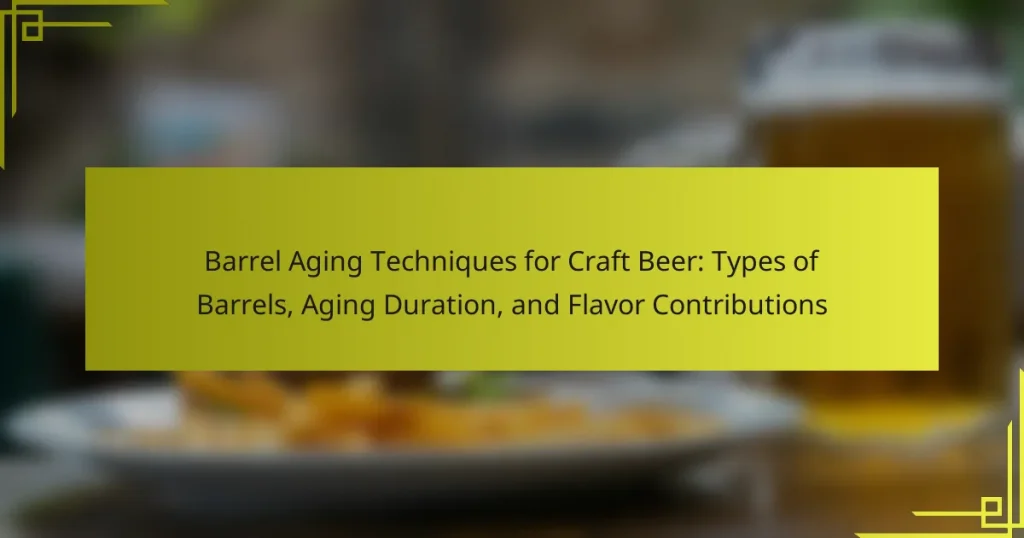Barrel aging techniques for craft beer involve the maturation of beer in wooden barrels, primarily made from oak. This process allows beer to absorb flavors from the wood and any previous contents of the barrel, such as bourbon or wine, resulting in enhanced complexity and unique characteristics. The aging duration can range from a few months to several years, during which the beer develops deeper flavors, aromas, and an improved mouthfeel. Key flavor contributions include notes of vanilla, caramel, and spice, influenced by the type of wood and the barrel’s prior use. Temperature control and careful monitoring of aging conditions are essential for optimizing flavor development in barrel-aged beers.

What are Barrel Aging Techniques for Craft Beer?
Barrel aging techniques for craft beer involve the process of maturing beer in wooden barrels. These barrels can be made from various types of wood, including oak, which is most commonly used. The aging process allows the beer to absorb flavors from the wood, enhancing its complexity. Different barrels impart unique characteristics based on their previous contents, such as bourbon or wine. The duration of aging can vary, typically ranging from a few months to several years. During this time, the beer develops deeper flavors and aromas. Additionally, the interaction with the wood can contribute to the beer’s mouthfeel and overall balance. This technique is widely used in crafting specialty beers, particularly in styles like stouts and sours.
How do barrel aging techniques enhance the flavor of craft beer?
Barrel aging techniques enhance the flavor of craft beer by allowing the beer to interact with the wood of the barrel. This interaction imparts unique flavors such as vanilla, caramel, and spice. The type of wood used, such as oak, significantly influences the flavor profile. Oak barrels can contribute tannins and compounds that add complexity. Additionally, the aging process allows for oxidation, which can soften harsh flavors and integrate the beer’s components. Studies show that barrel-aged beers often have more depth and richness compared to non-barrel-aged counterparts. The duration of aging also plays a crucial role; longer aging times can lead to more pronounced flavors. Overall, barrel aging creates a distinctive taste experience that is highly sought after in the craft beer community.
What is the role of wood in barrel aging?
Wood plays a critical role in barrel aging by imparting flavors and characteristics to the beverage. The wood’s natural compounds, such as lignin and tannins, contribute to the complexity of flavors. During aging, the beverage interacts with the wood, allowing for the extraction of these compounds. This process can enhance aromas and add notes like vanilla, caramel, and spice. Additionally, wood allows for micro-oxygenation, which softens the beverage’s tannins and promotes maturation. The type of wood used, such as oak, further influences the flavor profile. For example, American oak tends to impart sweeter flavors, while European oak offers spicier notes. Research shows that barrel aging can significantly alter the sensory attributes of craft beer, enhancing overall quality.
How does the aging process affect beer characteristics?
The aging process significantly alters beer characteristics. It can enhance flavors, aromas, and mouthfeel. During aging, oxidation occurs, which mellows harsh flavors. This process can lead to the development of complex notes, such as caramel, toffee, or dried fruit.
The interaction with barrel wood adds additional flavors, including vanilla, spice, and oak. The duration of aging impacts these changes; longer aging can intensify the effects. Studies show that certain styles, like stouts and barleywines, benefit more from aging than lighter beers.
Research indicates that beers aged in bourbon barrels can absorb compounds that enhance flavor profiles. For example, the American Society of Brewing Chemists highlights how barrel aging contributes to unique sensory experiences in craft beers.
What types of barrels are commonly used for aging craft beer?
Common types of barrels used for aging craft beer include oak barrels, bourbon barrels, and wine barrels. Oak barrels are favored for their ability to impart flavors and tannins to the beer. Bourbon barrels add distinct notes of vanilla and caramel due to their previous contents. Wine barrels, such as those from red or white wines, contribute complex flavors and aromas. These barrels enhance the beer’s character through the aging process. The usage of various barrels allows brewers to create diverse flavor profiles.
What are the differences between new and used barrels?
New barrels are made from fresh wood and offer distinct characteristics compared to used barrels. New barrels impart strong flavors and tannins to the contents. This is due to the unseasoned wood, which has not been previously exposed to liquid. The toasting and charring process also enhances these flavor contributions.
Used barrels, on the other hand, have already aged a liquid, which alters their flavor profile. They typically provide subtler flavors and allow for more gentle aging. The previous contents, such as whiskey or wine, can leave residual flavors in the wood.
The choice between new and used barrels affects the final taste of the beer. New barrels are often preferred for bold flavors, while used barrels are chosen for nuanced aging.
How do different wood types influence flavor profiles?
Different wood types significantly influence flavor profiles in barrel-aged beverages. Oak is the most common wood used in barrel aging. It imparts flavors such as vanilla, caramel, and spice. American oak tends to provide sweeter and bolder flavors. French oak offers more subtle and complex notes, including baking spices and chocolate. Other woods, like cherry or maple, can add unique characteristics, such as fruity or syrupy flavors. The wood’s grain and toast level also affect flavor extraction. A tighter grain results in slower flavor release, while a heavier toast enhances caramelization. Studies show that the choice of wood can alter the sensory experience of the final product.
What factors influence the duration of barrel aging?
The duration of barrel aging is influenced by several factors. These include the type of barrel used, which can affect the extraction of flavors. The previous contents of the barrel also play a significant role. Barrels that held spirits or wine impart distinct characteristics to the beer. Environmental conditions, such as temperature and humidity, can accelerate or slow down the aging process. The beer style itself is crucial, as some styles benefit from longer aging periods. Oxygen exposure during aging can also impact flavor development. Lastly, the desired flavor profile dictates how long the beer should age in the barrel. Each of these factors contributes to the overall outcome of the barrel aging process.
How does aging duration impact flavor development?
Aging duration significantly impacts flavor development in craft beer. Longer aging periods allow for more complex flavor profiles to emerge. During aging, chemical reactions occur that enhance flavors and aromas. For example, esters and phenols develop over time, contributing fruity and spicy notes. Additionally, wood characteristics from barrels infuse into the beer, adding vanilla, caramel, or oak flavors. Research indicates that aging for six months to two years can lead to optimal flavor complexity. Studies show that flavors continue to evolve, with diminishing returns after a certain point. Thus, aging duration is crucial for achieving desired flavor outcomes in barrel-aged craft beer.
What are the signs that beer is ready for bottling after aging?
Beer is ready for bottling after aging when it exhibits specific signs. A stable flavor profile indicates that the beer has matured. Clarity is another sign; clear beer suggests that sediment has settled. The absence of off-flavors shows that fermentation is complete. Additionally, carbonation levels should be appropriate, indicating that the beer is well-balanced. Finally, a pleasant aroma indicates that the aging process has enhanced the beer’s characteristics. These signs collectively confirm that the beer is ready for bottling.

What are the flavor contributions from barrel aging?
Barrel aging contributes a variety of flavors to beverages, primarily from the wood and any previous contents of the barrel. Common flavor contributions include vanilla, caramel, and toffee, which result from the breakdown of lignin in the wood. Oak barrels often impart notes of spice, such as clove and nutmeg. The charred interior of the barrel adds smokiness and depth. Additionally, if the barrel previously held wine or spirits, it can introduce fruity or herbal undertones. The aging process allows these flavors to meld, creating a complex profile. Research indicates that the interaction between the beverage and the wood occurs over time, enhancing flavor development.
How do different barrels contribute unique flavors to craft beer?
Different barrels contribute unique flavors to craft beer through their wood type, previous contents, and aging process. Oak barrels are commonly used and impart vanilla, caramel, and spice notes. This is due to the natural compounds found in oak, such as lignin and vanillin. Barrels that previously held whiskey or wine add additional complexities. For instance, bourbon barrels can introduce sweet, toasty flavors, while wine barrels may add fruity or tannic characteristics. The duration of aging also affects flavor intensity. Longer aging periods typically result in more pronounced flavors. Additionally, the char level of the barrel influences the flavor profile. A heavier char can enhance smokiness and sweetness. Each barrel type and treatment offers a distinct flavor contribution, making the choice of barrel critical in craft beer production.
What flavors are associated with oak barrels?
Flavors associated with oak barrels include vanilla, caramel, and coconut. These flavors result from the chemical compounds released during the toasting and charring processes of the wood. Oak barrels also impart notes of spice, such as clove and nutmeg. Additionally, they can contribute a subtle smokiness and astringency. The specific flavors depend on the type of oak used, such as American or French oak. American oak tends to provide sweeter, bolder flavors, while French oak offers more subtle, nuanced characteristics. The aging duration further influences the intensity of these flavors. Longer aging typically results in more pronounced oak characteristics in the final product.
How do barrel treatments affect the final taste?
Barrel treatments significantly influence the final taste of craft beer. The type of wood used in barrels imparts distinct flavors. Common woods like oak add vanilla, caramel, and spice notes. The previous contents of the barrel also affect flavor. For example, barrels previously used for whiskey can introduce smoky and sweet characteristics.
The duration of aging impacts flavor intensity. Longer aging periods often result in more pronounced wood and tannin flavors. Additionally, barrel treatments can enhance complexity by allowing micro-oxygenation, which softens harsh flavors.
Research indicates that barrel aging can increase the overall aroma and mouthfeel of the beer. Studies show that beers aged in barrels exhibit a richer, fuller body compared to those fermented in stainless steel. Overall, barrel treatments are crucial in shaping the sensory profile of craft beer.
What are the common flavor profiles achieved through barrel aging?
Common flavor profiles achieved through barrel aging include vanilla, caramel, oak, and spice. These flavors result from the interaction between the beer and the wood of the barrel. Vanilla and caramel often come from the breakdown of lignin in the wood. Oak contributes a toasted flavor, enhancing the complexity of the beer. Spices such as clove and nutmeg can emerge depending on the type of barrel used. Additionally, some barrels impart fruity notes, like dried fruit or citrus. The aging duration also affects flavor intensity, with longer aging typically resulting in more pronounced flavors. These profiles are widely recognized in the craft beer community as essential characteristics of barrel-aged beers.
How do fruity, spicy, and smoky notes emerge in aged beer?
Fruity, spicy, and smoky notes emerge in aged beer primarily through interactions with the barrel wood. The aging process allows the beer to absorb compounds from the wood, such as vanillin and lignin. These compounds contribute to the complexity of flavors.
Fruity notes often develop from esters produced during fermentation. The aging process can enhance these esters, leading to more pronounced fruit flavors. Spicy notes can arise from the specific type of wood used, such as oak, which contains spice-related compounds.
Smoky notes may result from the charring or toasting of the barrel. This process creates a layer of char that imparts a smoky flavor to the beer. The duration of aging also plays a critical role; longer aging periods can intensify these flavors.
Research indicates that various barrel types, such as bourbon or wine barrels, can further influence these flavor profiles. The interaction between the beer and the barrel is a key factor in developing these distinct notes.
What role do adjuncts play in flavor enhancement during aging?
Adjuncts play a significant role in flavor enhancement during aging in craft beer. They are additional ingredients that complement the primary ingredients. Common adjuncts include spices, fruits, and sugars. These adjuncts can introduce unique flavors and aromas. For example, vanilla beans can add sweetness and depth. Similarly, fruits like cherries can contribute tartness and complexity. The interaction between adjuncts and the beer’s base flavors evolves during aging. This process can lead to a more rounded and intricate flavor profile. Studies show that the right adjuncts can enhance the overall sensory experience of the beer.

How can brewers optimize their barrel aging techniques?
Brewers can optimize their barrel aging techniques by carefully selecting barrel types and monitoring aging conditions. Different wood types impart unique flavors. For example, oak barrels contribute vanilla and spice notes. Brewers should also consider the previous contents of the barrels. Used barrels from whiskey or wine can enhance complexity.
Temperature control is crucial during aging. Consistent temperatures prevent unwanted flavor development. Humidity levels in the aging environment can also affect evaporation rates. Brewers need to regularly taste the beer to track flavor evolution. This ensures the desired profile is achieved before bottling.
Data from the Brewers Association indicates that barrel aging can enhance flavor complexity significantly. A study showed that beers aged in bourbon barrels had a 25% increase in flavor depth compared to non-aged counterparts. By implementing these strategies, brewers can enhance the quality and uniqueness of their barrel-aged beers.
What best practices should brewers follow for successful barrel aging?
Brewers should follow several best practices for successful barrel aging. First, select high-quality barrels that have been properly sanitized. This ensures that unwanted microorganisms do not contaminate the beer. Second, monitor the temperature and humidity of the aging environment. Consistent conditions help maintain the integrity of the beer during aging. Third, regularly sample the beer to assess flavor development. This allows brewers to determine the optimal aging duration. Fourth, consider the previous contents of the barrel. Different spirits or wines impart unique flavors to the beer. Fifth, ensure proper filling and emptying of barrels to minimize oxidation. This preserves the beer’s freshness and flavor profile. Finally, document the aging process meticulously. Detailed records help replicate successful batches in the future. Following these practices can lead to a high-quality barrel-aged beer.
How can brewers monitor and adjust the aging process?
Brewers can monitor and adjust the aging process by regularly sampling the beer. This allows them to evaluate flavor development and detect any off-flavors. They can also measure specific gravity to track fermentation progress. Monitoring temperature and humidity in the aging environment is crucial for consistency. Adjustments can be made by altering the aging duration based on flavor assessments. Additionally, brewers can manipulate barrel types to influence flavor profiles. Using a combination of these methods ensures optimal aging outcomes. Regular monitoring leads to a better understanding of how aging affects the final product.
What common mistakes should be avoided in barrel aging?
Common mistakes to avoid in barrel aging include using barrels that are not properly cleaned. Dirty barrels can introduce unwanted flavors and spoilage microorganisms. Another mistake is over-aging beer in barrels. This can lead to excessive wood flavors and astringency. Temperature fluctuations during aging should also be avoided. Consistent temperatures help maintain flavor stability. Additionally, not monitoring the beer regularly can result in off-flavors developing unnoticed. Lastly, neglecting to fill barrels completely can lead to oxidation. Proper filling minimizes air exposure, preserving the beer’s quality.
What resources are available for brewers interested in barrel aging?
Brewers interested in barrel aging can access various resources. Industry publications provide insights into techniques and best practices. Online forums and communities allow brewers to share experiences and tips. Educational workshops and seminars often focus on barrel aging methods. Additionally, local breweries may offer mentorship programs. Suppliers of barrels and related equipment provide technical support and guidance. Research studies on flavor development in barrel-aged beers also serve as valuable resources. These resources collectively enhance brewers’ understanding and execution of barrel aging.
How can brewers connect with experienced barrel-aging experts?
Brewers can connect with experienced barrel-aging experts through industry networking events. These events often feature workshops and panels led by knowledgeable professionals. Additionally, joining brewing associations can provide access to expert directories. Online forums and social media groups focused on barrel aging are also valuable resources. Collaborating with local distilleries may lead to mentorship opportunities. Attending trade shows allows brewers to meet experts face-to-face. Participating in barrel-aging competitions can also facilitate connections. Engaging with educational programs or courses on barrel aging further enhances networking possibilities.
What literature or courses can enhance knowledge of barrel aging?
Books such as “Barrel-Aging Beer: A Practical Guide” by Greg Noonan enhance knowledge of barrel aging. This book provides practical insights on various barrel types and aging techniques. Additionally, “The Brewer’s Association’s Guide to Barrel Aging” offers extensive information on flavor contributions from different barrels. Online courses like “Barrel-Aging Techniques for Craft Beer” from the American Brewers Association provide structured learning. These resources cover essential topics including barrel selection, aging duration, and flavor profiles. They are valuable for both novice and experienced brewers seeking to improve their craft.
Barrel aging techniques for craft beer involve maturing beer in wooden barrels, primarily oak, to enhance flavor complexity. The article explores various barrel types, including bourbon and wine barrels, and their unique contributions to flavor profiles, such as vanilla, caramel, and spice. It details the impact of aging duration on flavor development, the role of wood in imparting characteristics, and best practices for brewers to optimize their barrel aging processes. Additionally, it highlights common mistakes to avoid and resources available for brewers interested in improving their barrel aging techniques.




